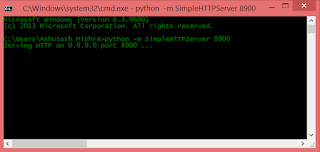Html Status Code
Basic Html Status Code Types
1- 1XX [Informational]
2- 2XX [Success]
3- 3XX [Redirect]
4- 4XX [Client Error]
5- 5XX [Server Error]
-----------------------------------------------------------------------------------------------------------------------
1xx Informational
a- 100 Continue
b- 101 Switching Protocols
c- 102 Processing
2xx Success
This class of status codes indicates the action requested by the client was received, understood, accepted and processed successfully.
- 200 OK
- 201 Created
- 202 Accepted
- 203 Non-Authoritative Information (since HTTP/1.1)
- 204 No Content
- 205 Reset Content
- 206 Partial Content
- 207 Multi-Status (WebDAV; RFC 4918)
- 208 Already Reported (WebDAV; RFC 5842)
- 226 IM Used (RFC 3229)
3xx Redirection
This class of status code indicates the client must take additional action to complete the request. Many of these status codes are used in URL redirection.
A user agent may carry out the additional action with no user interaction only if the method used in the second request is GET or HEAD. A user agent should not automatically redirect a request more than five times, since such redirections usually indicate an infinite loop.
- 300 Multiple Choices
- 301 Moved Permanently
- 302 Found
- 303 See Other (since HTTP/1.1)
- 304 Not Modified
- 305 Use Proxy (since HTTP/1.1)
- 306 Switch Proxy
- 307 Temporary Redirect (since HTTP/1.1)
- 308 Permanent Redirect (Experimental RFC; RFC 7238)
4xx Client Error
The 4xx class of status code is intended for cases in which the client seems to have erred. Except when responding to a HEAD request, the server should include an entity containing an explanation of the error situation, and whether it is a temporary or permanent condition. These status codes are applicable to any request method. User agents should display any included entity to the user.
- 400 Bad Request
- 401 Unauthorized
- 402 Payment Required
- 403 Forbidden
- 404 Not Found
- 405 Method Not Allowed
- 406 Not Acceptable
- 407 Proxy Authentication Required
- 408 Request Timeout
- 409 Conflict
- 410 Gone
- 411 Length Required
- 412 Precondition Failed
- 413 Request Entity Too Large
- 414 Request-URI Too Long
- 415 Unsupported Media Type
- 416 Requested Range Not Satisfiable
- 417 Expectation Failed
- 418 I'm a teapot (RFC 2324)
- 419 Authentication Timeout
- 420 Method Failure (Spring Framework)
- 420 Enhance Your Calm (Twitter)
- 422 Unprocessable Entity (WebDAV; RFC 4918)
- 423 Locked (WebDAV; RFC 4918)
- 424 Failed Dependency (WebDAV; RFC 4918)
- 426 Upgrade Required
- 428 Precondition Required
- 429 Too Many Requests
- 431 Request Header Fields Too Large
- 440 Login Timeout (Microsoft)
- 444 No Response (Nginx)
- 449 Retry With (Microsoft)
- 450 Blocked by Windows Parental Controls (Microsoft)
- 451 Unavailable For Legal Reasons (Internet draft)
- 451 Redirect (Microsoft)
- 494 Request Header Too Large (Nginx)
- 495 Cert Error (Nginx)
- 496 No Cert (Nginx)
- 497 HTTP to HTTPS (Nginx)
- 498 Token expired/invalid (Esri)
- 499 Client Closed Request (Nginx)
- 499 Token required (Esri)
5xx Server Error
The server failed to fulfill an apparently valid request.
Response status codes beginning with the digit "5" indicate cases in which the server is aware that it has encountered an error or is otherwise incapable of performing the request. Except when responding to a HEAD request, the server should include an entity containing an explanation of the error situation, and indicate whether it is a temporary or permanent condition. Likewise, user agents should display any included entity to the user. These response codes are applicable to any request method.
- 500 Internal Server Error
- 501 Not Implemented
- 502 Bad Gateway
- 503 Service Unavailable
- 504 Gateway Timeout
- 505 HTTP Version Not Supported
- 506 Variant Also Negotiates (RFC 2295)
- 507 Insufficient Storage (WebDAV; RFC 4918)
- 508 Loop Detected (WebDAV; RFC 5842)
- 509 Bandwidth Limit Exceeded (Apache bw/limited extension)
- 510 Not Extended (RFC 2774)
- 511 Network Authentication Required
- 598 Network read timeout error (Unknown)
- 599 Network connect timeout error (Unknown)
- For more details go Wikipedia.
- Reference : Wikipedia http status code


Comments
Post a Comment